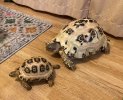Keil Gries
New Member
I have a leopard tortoise that just started laying a similar type of very goopy underdeveloped egg as you describe. She has been passing them when I bathe her. There have been 3 so far, and it has been making me extremely nervous as it was hard to find information about, and it seemed so strange. After looking for a couple weeks I finally just found this post. I will try to up the calcium intake although I normally powder her grass with it when I feed her and also provide cactus pads.




